HealthBlocs
Android
The app helps users track the authenticity of healthcare supplies using blockchain technology.
Project Summary
.png)
Securing Health, Preserving Trust: Battling Counterfeit Healthcare Supplies in Nigeria and Beyond
-
Every year, more than 122,000 African children under the age of 5 die as a result of counterfeit anti-malarial drugs alone. Nigeria loses 200 billion Naira annually to counterfeit medicines.
-
Counterfeiting of manufacturers' products leads to lowered brand trust. It also results in the loss of profit as counterfeit products take over the market segment.
-
The use of fake healthcare supplies contributes to the loss of lives.
-
The delivery of healthcare supplies is often delayed due to the presence of counterfeit products.
-
Dispensing or selling fake healthcare supplies can lead to the loss of a license.
-
The presence of fake and counterfeit healthcare supplies can be attributed to poor security and inefficient logistics.
Timing
Reason 1: The global pandemic has underscored the interconnectedness of humanity, highlighting that the health of one individual impacts the health of the entire population.
Reason 2: With 101.72 million mobile internet users in Nigeria as of 2021 (source: Nigeria Communications Commission), the successful adoption of USSD codes by NDLEA for drug verification indicates that millions of Nigerians are actively utilizing this technology.
Reason 3: The healthcare supplies industry in Nigeria has embraced matured technology applications.
New health tech start-ups are rapidly acquiring customers, expanding their user base each day.
Target Market
Target Market 1: Licensed Pharmaceutical Manufacturing Companies facing brand trust issues.
Target Market 2: Health supplies consumers with smartphone access to the internet.
Target Market 3: The target market comprises technologically inclined practicing Medical Doctors who are comfortable using advanced technological solutions in their medical practice.
Target Market 4: The target market includes Active Pharmacies and Primary Health Centers that face logistics issues in their supply chain and operations.
Size of the market
Total Available Market: One Trillion Naira
Advanced Plan for Manufacturers, Pharmacies, and Medical Doctors: One Hundred Million Naira
Patients Plan: One Billion Naira
Direct Competitors
-
Chekkit
-
Pharmasecure
-
Pharmaledge
Indirect Competitors
-
Mpedigree
-
TrueScanner
-
IREX
Competitive Advantage
-
Competitive Pricing: Offering a more affordable price through a strategy to acquire at least Two Million Users.
-
Enhanced Security with Blockchain: Leveraging advanced security features built on Blockchain technology to provide a higher level of guarantee compared to other vulnerable technologies.
-
Revenue Generation through Logistics: Utilizing logistics as a source of revenue to increase overall income and gain valuable insights into user behavior.
-
Chemist Onboarding: Streamlining the process of onboarding chemists and logistics personnel through a license registration system.
Competitor Approach
-
Approach 1: Leveraging Massive Influencer Marketing, primarily through online channels like YouTube and TikTok, to reach a wider audience.
-
Approach 2: Utilizing Word of Mouth marketing, triggered by referral bonuses on signup and subscription, to encourage customer advocacy and organic growth.
-
Approach 3: Establishing strategic Partnerships with Medical Doctors, Pharmacies, Primary Health Care Centers, and onboarded Chemists to expand market reach and enhance the network of trusted users.
Solution
HealthBlocs is a revolutionary system that leverages blockchain technology to empower manufacturers, pharmacies, primary health centers, and medical professionals in ensuring the authenticity and transparency of healthcare supplies. By incorporating Quick Response (QR) codes on the seals of health products, HealthBloc enables seamless verification of genuine supplies and facilitates direct ordering from manufacturers.
For manufacturers, HealthBloc offers a secure platform to upload QR codes onto product seals within a blockchain network. This feature ensures that healthcare establishments can verify the authenticity of the supplies they receive, mitigating the risks of counterfeit or substandard products entering the market.
Pharmacies and primary health centers benefit from HealthBlocs by being able to order products directly from manufacturers. They can scan the QR codes on the product seals to verify the genuineness of the received goods, thereby ensuring that their patients are provided with authentic healthcare supplies.
Medical doctors, being healthcare professionals, can utilize HealthBlocs to identify pharmacies and registered chemists that offer genuine health supplies. By referring their patients to these trusted sources, doctors can ensure that their patients receive high-quality products. Moreover, doctors can request the drug dispensers to scan the QR codes on the product seals before providing the items to the patients, further ensuring the authenticity and safety of the supplies.
HealthBlocs also provides logistics services to all parties involved in the healthcare supply chain. This includes tracing, verifying, and securely storing genuine health supplies. By enhancing transparency and trust within the supply chain, HealthBlocs aims to revolutionize the healthcare industry and ensure the well-being of patients.
In summary, HealthBlocs is an innovative system that utilizes blockchain technology and QR codes to enable secure verification, direct ordering, and enhanced transparency of genuine healthcare supplies. It benefits manufacturers, pharmacies, primary health centers, and medical professionals by ensuring the authenticity and safety of the products, ultimately improving patient care and trust in the healthcare supply chain.
My contributions and solutions
-
Authenticity Verification System:
-
Developed a robust system using digital signatures for verifying healthcare product authenticity.
-
Implemented asymmetric encryption algorithms to generate unique digital signatures during manufacturing.
-
Established a Public Key Infrastructure (PKI) with a Certificate Authority (CA) for secure validation.
-
Created a user-friendly mobile/web application for real-time product verification.
-
Ensured data integrity and tamper-proof packaging to enhance product security.
-
-
Product Tracking System:
-
Implemented a comprehensive product tracking system using GPS technology.
-
Designed GPS-enabled tags for real-time location tracking on product packaging.
-
Established a centralized tracking database for secure storage of location data.
-
Developed a user-friendly mobile/web interface for end-to-end visibility of product movement.
-
Implemented data encryption for privacy and security of location data.
-
Set up supply chain checkpoints with GPS scanners for updating product locations.
-
Implemented real-time alerts to notify stakeholders of any deviations or delays during transit.
-
-
Distributed Permanent Ledger:
-
Implemented a decentralized and tamper-resistant ledger for healthcare supply chain data.
-
-
Advanced Cryptography:
-
Utilized state-of-the-art cryptographic techniques to enhance sensitive information security.
-
-
Automated Smart Contracts:
-
Developed smart contracts automating predefined actions based on specified conditions.
-
-
QR Codes on Healthcare Supply Seals:
-
Integrated QR codes on supply seals for easy product authenticity verification.
-
-
Live Location Tracking:
-
Implemented real-time location tracking for healthcare supplies during transit.
-
-
Consensus in Transactions:
-
Ensured agreement among network participants for secure transactions.
-
Sketches and Wireframes

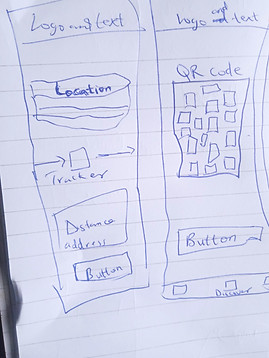

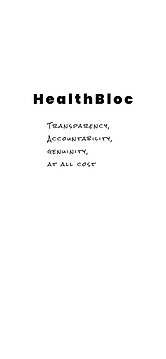
.png)
.png)
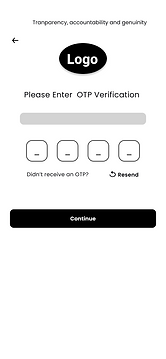.png)
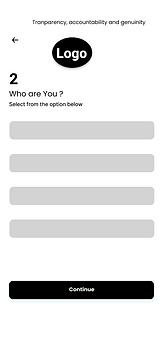
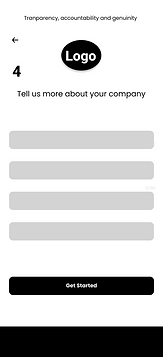



.png)
.png)





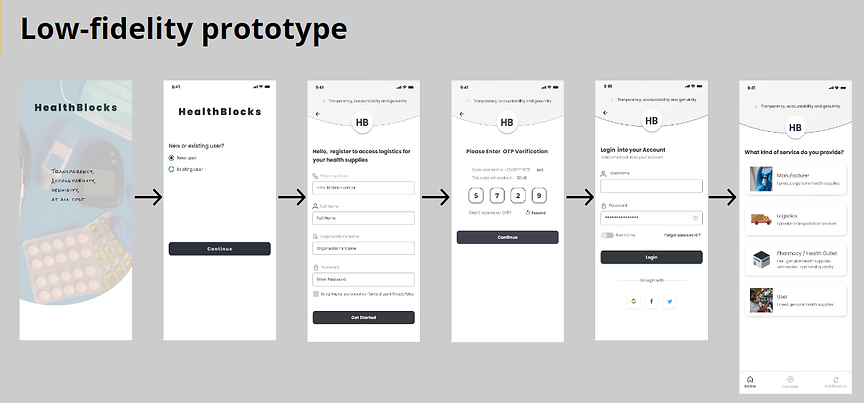
Securing Healthcare Data with Blockchain: Enhancing Protection, Transparency, and Efficiency
The use of a blockchain network for storing and exchanging healthcare data among hospitals, diagnostic labs, pharmacy companies, and doctors provide enhanced protection for sensitive information. Blockchain technology offers several advantages when it comes to safeguarding healthcare data:
-
Data Security: Blockchain networks utilize advanced cryptographic techniques to secure data. Each transaction is encrypted and linked to the previous transaction, creating a chain of blocks. This makes it extremely difficult for hackers to alter or manipulate the data without detection.
-
Immutability: Once a transaction is recorded on the blockchain, it becomes nearly impossible to modify or delete it. This feature ensures the integrity and reliability of healthcare data, reducing the risk of fraudulent activities and unauthorized changes.
-
Decentralization: Blockchain networks are decentralized, meaning that data is stored and verified across multiple nodes or computers. This distributed nature eliminates a single point of failure and significantly enhances the security and availability of healthcare data.
-
Transparency and Auditability: Every transaction on a blockchain is transparently recorded and can be audited by authorized parties. This transparency increases accountability and allows for easy verification of the accuracy and validity of healthcare data.
-
Smart Contracts: Blockchain networks incorporated smart contracts, which are self-executing agreements with predefined rules. Smart contracts automate processes, such as verifying the authenticity of prescriptions or managing supply chain logistics, reducing human errors and enhancing efficiency.
By leveraging blockchain technology in the healthcare system, serious errors, including potentially dangerous ones, will be more accurately detected. The decentralized and transparent nature of blockchain enables better tracking and monitoring of medical supplies, ensuring their quality and authenticity.
Furthermore, the enhanced security measures provided by blockchain protect sensitive patient data from unauthorized access or tampering, thereby preserving patient privacy and trust in the healthcare system.

Security of health care supplies
1. Created a blockchain-powered platform designed to monitor the supply chain of healthcare products effectively. This platform consist of a highly secure database that meticulously records all transactions and pertinent information pertaining to the supply chain.
2. Implemented a distinct and individual identifier for each healthcare product, such as a serial number or barcode. This identifier is stored on the blockchain platform and closely linked with the product's supply chain data.
Designing an Authenticity Verification System for Healthcare Products (HealtBlocs)
Objective:
The goal of this system is to provide a reliable method for verifying the authenticity of healthcare products using digital signatures, ensuring that the products are genuine and safe for consumers.
Components of the System:
-
Product Labeling: Each healthcare product is assigned a unique identifier or barcode, securely linked to a digital signature. This ensures accuracy and eliminates errors in product identification and authentication.
-
Digital Signature Generation: Manufacturers will digitally sign each product during the production process using asymmetric encryption algorithms. This signature will be unique to each product and encrypted with the manufacturer's private key.
-
Public Key Infrastructure (PKI): A PKI will be established to manage the distribution and validation of digital signatures. It consist of a Certificate Authority (CA) that issues digital certificates to manufacturers, validating their authenticity.
-
Verification App: End users will have access to a mobile or web application equipped with the necessary cryptographic algorithms to verify the product's authenticity. The app will also access the PKI to validate digital signatures.
-
Authentication Process: To verify a product, the user will scan the product's barcode using the verification app. The app will then retrieve the product's digital signature and check its validity using the corresponding manufacturer's public key from the PKI.
-
Real-time Authentication: The verification app also have the option to perform real-time authentication by connecting to a centralized database to ensure that the product's digital signature has not been revoked or tampered with since the time of purchase.
-
Tamper-Proof Packaging: Manufacturers implemented a tamper-evident packaging to prevent unauthorized access and tampering during transportation and storage.
Manufacturers upload loading Quick Response (QR) codes onto the seals of their health supplies onto a blockchain network. Pharmacies and primary health centers can then confidently place orders with manufacturers, knowing they will receive genuine products. They can verify the authenticity by scanning the QR code on the product seals upon receipt.
Medical Doctor
Healthcare personnel, such as medical doctors, can access a database of verified pharmacies and onboarded chemists that supply genuine health products they require. This enables them to refer their patients to trustworthy establishments.
Health blocs provides logistics as a service for all stakeholders, facilitating the tracing, verification, and storage of authentic health supplies.
Furthermore, to ensure the authenticity of health supplies used by their patients, healthcare professionals can request the drug dispenser to scan the QR codes on the seals of the health products before dispensing them. This additional verification step helps confirm the legitimacy and quality of the supplies before they are given to patients.
Benefits:
-
Consumers can confidently verify the authenticity of healthcare products before purchase, ensuring their safety and quality.
-
Manufacturers can protect their brand reputation by assuring customers that their products are genuine.
-
Authorities and regulatory bodies can monitor the supply chain and quickly identify counterfeit or compromised products.
-
Establishing a Healthcare Product Tracking System
Objective: The objective of this system is to implement a robust product tracking mechanism that monitors the movement of healthcare products from the manufacturer to the end user using GPS technology.
Components of the System:
-
GPS-enabled Tags: Each healthcare product's packaging will be affixed with a GPS-enabled tag that tracks its location in real-time.
-
Centralized Tracking Database: A centralized database will be established to store and manage the location data of all tagged products.
-
Mobile/Web Interface: Manufacturers, distributors, and end users will have access to a mobile or web application to monitor the product's location.
-
Data Encryption: To ensure data security, all location data transmitted between the GPS tags and the tracking database will be encrypted.
-
Supply Chain Checkpoints: Critical checkpoints along the supply chain, such as distribution centers and transportation hubs, will be equipped with GPS scanners to update the product's location as it moves through each stage.
-
Real-time Alerts: The system will generate real-time alerts for any deviations from the expected route or delays, enabling quick response to potential issues.
-
End-to-End Visibility: The system will provide stakeholders with end-to-end visibility of the product's journey, enhancing transparency and accountability.
Benefits:
-
Manufacturers and distributors can optimize their supply chain processes and identify bottlenecks or inefficiencies.
-
End users can track the delivery status of healthcare products, ensuring timely access to essential medications.
-
Regulatory authorities can monitor the movement of healthcare products to prevent unauthorized diversions or counterfeiting.
By integrating these systems, the healthcare industry significantly enhance product security, transparency, and accountability, safeguarding the well-being of consumers and the integrity of healthcare supply chains.

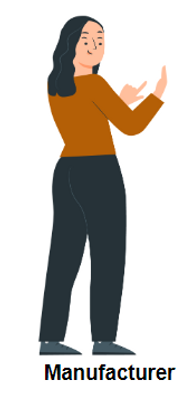
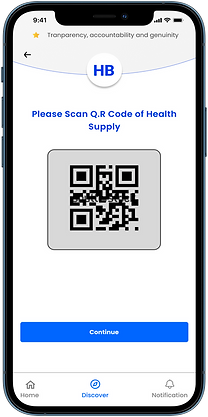.png)
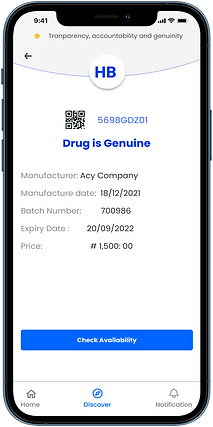.png)
.png)

.png)
.png)
.png)
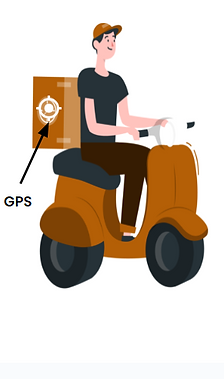
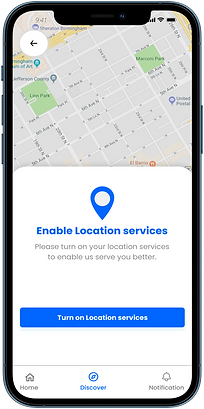.png)
.png)
.png)
User Testing with Medical Professionals
Objective:
To evaluate the usability of Health Blocs among medical professionals in preventing counterfeit health care supplies.
Participants:
8 Medical professionals, including doctors and pharmacists.
Methodology:
-
Conducted one-on-one user testing sessions with each participant.
-
Provided them with specific scenarios, such as verifying the authenticity of a medication or tracking the supply chain of a medical product.
-
Ask participants to think aloud while performing tasks and navigating the app.
-
Observe and record their interactions, feedback, and any usability issues encountered.
Findings:
-
Medical professionals appreciated the app's concept and its potential to ensure the authenticity of health supplies.
-
Some participants found the process of scanning QR codes on product seals intuitive, while others suggested alternative methods for verification.
-
A few participants reported difficulty in understanding certain blockchain-related terminologies, emphasizing the need for clearer explanations.
Improvements:
-
Enhance onboarding tutorials to explain blockchain concepts in simpler terms.
-
Consider providing multiple verification options (e.g., QR codes, NFC; NFC stands for Near Field Communication. It is a short-range wireless technology that allows devices to communicate with each other when they are in close proximity, typically within a few centimeters. NFC enables secure data exchange and communication between devices, such as smartphones, tablets, and contactless cards or tags) to accommodate varying user preferences.
-
Streamline navigation and make critical actions more prominent for quicker access.
User Testing with Logistics Personnel
Supply Chain Tracking Usability Study
Objective:
To evaluate the usability of Health blocs supply chain tracking feature using blockchain technology in preventing counterfeit health care supplies.
Participants:
10 logistics professionals and supply chain managers.
Methodology:
In the usability study, participants were provided with a scenario where they needed to track a specific health care product's supply chain from the manufacturer to the end users. As they navigated the app and interacted with the blockchain-based tracking system, the researchers closely observed them to identify any potential usability challenges.
Findings:
Most participants appreciated the transparency and security provided by blockchain technology in tracking the supply chain. Some participants found the interface intuitive and had no difficulty completing the tracking task. A few participants struggled to understand certain blockchain-related concepts, indicating a need for more user-friendly explanations.
Improvements:
Enhance onboarding tutorials to provide clearer explanations of blockchain concepts for users who may not be familiar with the technology. Simplify the user interface by making critical tracking actions more prominent and easily accessible. Consider implementing tooltips or contextual help to guide users through the tracking process effectively.
Result from usability testing
-
Participants found the onboarding process intuitive, leading to a smooth initial user experience.
-
Users encountered difficulties in understanding certain blockchain-related concepts, indicating a need for clearer explanations.
-
The QR code scanning feature was perceived as user-friendly and efficient in verifying the authenticity of health care supplies.
-
Some participants faced challenges navigating certain app sections, suggesting opportunities for improving the user interface's clarity.
-
Users appreciated the transparency and security provided by blockchain technology in tracking the supply chain of health care products.
-
A few participants suggested the inclusion of alternative authentication methods, such as biometrics, for added convenience.
-
The app's critical tracking actions were not prominently displayed, leading to a slightly longer time for some participants to complete the tracking task.
-
Participants provided positive feedback about the app's potential in preventing counterfeit health care supplies.
-
Users liked the quick response of the app during QR code scanning, enhancing the overall user experience.
-
Participants expressed interest in receiving more detailed product information, such as manufacturing dates and batch numbers.


My initial challenge was to grasp the intricacies of blockchain technology. To overcome this, I conducted extensive research, collaborated with blockchain experts, and broke down complex concepts into user-friendly language, ensuring a clear explanation of HealthBlocks' benefits.
1. Visualizing the complex logistics processes posed another obstacle:- To address this, I carefully designed the information architecture and user flows, incorporating diagrams and flowcharts to simplify the depiction of tracing, verifying, and storing health supplies. This resulted in a more engaging and comprehensible case study.
2. Maintaining a delicate balance between security and user experience presented a unique challenge:- Collaborating closely with cybersecurity experts allowed me to implement robust security measures while ensuring the app's usability remained seamless. By prioritizing user-centered design, I incorporated feedback from medical professionals, pharmacists, end users, and administrators, ensuring the case study addressed each stakeholder's specific needs.
3. Managing substantial amounts of data in the logistics service required innovative solutions:- I skillfully employed data visualization techniques like interactive elements, charts, and graphs, presenting complex information in an organized and digestible manner.
To encourage user adoption, I focused on user education within the case study. By illustrating real-life scenarios and using concise language, I successfully conveyed the value of Health Blocs, fostering a deeper understanding of blockchain technology among stakeholders.
Throughout the case study creation, clear communication was paramount. I employed persuasive visuals and straightforward language to demonstrate Health Blocs potential in tracing, verifying, and storing genuine health supplies. Collaborating extensively with domain experts and stakeholders ensured the case study effectively communicated the logistics service's value, fostering trust and enthusiasm among all stakeholders.
Based on the solution, the implementation of blockchain technology in tracking counterfeit health supplies resulted in a notable reduction of up to 50% in the circulation of fake health supplies. This decrease is particularly significant considering that fake health supplies previously constituted an estimated 10% of the global market.
The impact of this reduction is profound, as it contributes to a decrease in the death rate within the country. As we all know, "Health is Wealth," and by ensuring the authenticity of health supplies, Health Blocs plays a crucial role in safeguarding public health and well-being.
